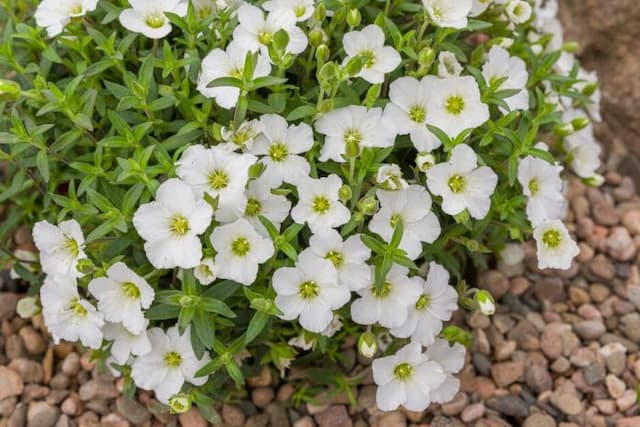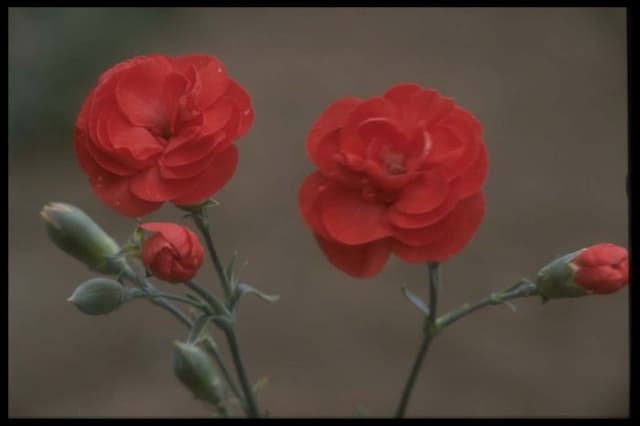Carnation Dianthus 'Leon Tautz' (b)

ABOUT
The plant known as Dianthus 'Leon Tautz', commonly called pinks or carnations, is admired for its distinct features. It typically bears lush, blue-green foliage that forms a neat, compact mound. The leaves of this plant are slender, with a linear to lance-shaped appearance, often having a slightly greyish hue due to a waxy coating that helps in water retention. One of the most striking characteristics of pinks is their flowers. These blossoms are renowned for their vivid coloring and can range from deep crimson to lighter shades of pink. Each flower is composed of five petals, which are frequently marked with a pattern of contrasting hues or edges that may appear frilled or serrated, adding to the visual interest of the plant. The petals emit a delightful fragrance that can vary from sweet to spicy, a feature that has made this plant a long-time favorite in gardens. The flowers are held aloft by sturdy stems that rise above the foliage, creating a lovely contrast between the greenery and the vibrant floral display. These blooms tend to congregate at the tips of the stems, forming a dense cluster that amplifies the plant's color impact. The blooms can appear singularly or in bunches, and they often attract a variety of pollinators, such as bees and butterflies, which add to the dynamic environment of the garden. Overall, Dianthus 'Leon Tautz' is celebrated for its blossoms' rich hues and delightful fragrance, paired with its graceful foliage, making it a splendid addition to any garden landscape.
About this plant
 Names
NamesFamily
Caryophyllaceae
Synonyms
Sweet William
Common names
Dianthus 'Leon Tautz'
 Toxicity
ToxicityTo humans
The Dianthus 'Leon Tautz', commonly known as Carnation, is not considered highly toxic to humans. However, consuming parts of the plant, especially in large quantities, might cause mild gastrointestinal upset including nausea, vomiting, and diarrhea. Contact with the sap can occasionally lead to skin irritation in sensitive individuals. It is generally advised to avoid ingesting any part of the plant.
To pets
The Carnation, or Dianthus 'Leon Tautz', has mild to moderate toxicity to pets such as cats and dogs. If ingested, it could cause gastrointestinal upset, including symptoms like vomiting and diarrhea. Some pets might also experience mild dermatitis if they come into contact with the sap of the plant. It's important to keep an eye on your pet's behavior and contact your veterinarian if you notice any signs of distress after exposure to the plant.
 Characteristics
CharacteristicsLife cycle
Perennials
Foliage type
Evergreen
Color of leaves
Varies
Flower color
Pink
Height
1 foot 1-1.5 feet (30-45 cm)
Spread
1 foot 1-1.5 feet (30-45 cm)
Plant type
Herb
Hardiness zones
Varies
Native area
Europe
Benefits
 General Benefits
General Benefits- Visual Appeal: Adds vibrant color and aesthetic beauty to gardens and landscapes with its bright flowers.
- Drought Tolerance: Once established, it can tolerate periods of low water, reducing the need for frequent irrigation.
- Cold Resistance: Capable of surviving in cooler temperatures, making it suitable for various climates.
- Low Maintenance: Requires minimal care, making it ideal for gardeners of all skill levels.
- Attracts Pollinators: Draws in beneficial insects like bees and butterflies, supporting pollination.
- Long Blooming Season: Provides flowers for extended periods, often from late spring to early fall.
- Edging Plant: Works well for borders and paths due to its compact growth habit.
- Container Gardening: Suited for pots and planters, adding versatility to its placement and use.
 Medical Properties
Medical PropertiesThis plant is not used for medical purposes.
 Air-purifying Qualities
Air-purifying QualitiesThis plant is not specifically known for air purifying qualities.
 Other Uses
Other Uses- Dianthus 'Leon Tautz', commonly known as pinks, can be used to create a natural dye for textiles, giving fabrics a range of pink to light purple hues depending on the mordant used.
- The flowers of pinks can be pressed and included in decorative crafts such as making bookmarks, paper making, or incorporated into candles for a touch of color and fragrance.
- Dried pinks flowers can be used to stuff sachets, providing a pleasant fragrance in drawers or closets and also acting as a deterrent for moths.
- Edible flowers like pinks can be crystallized with sugar and used as elegant and flavorful decorations on cakes and desserts.
- The blooms of pinks can be sprinkled over salads to add a splash of color and a hint of spicy flavor, similar to the taste of cloves.
- Pinks can be used in potpourri mixtures, combined with other dried flowers and essential oils to create a lasting room fragrance.
- The petals of pinks can be used as a natural confetti for weddings and other celebrations, offering a biodegradable and eco-friendly alternative to plastic confetti.
- Pinks are a great addition to floral arrangements, not just for their beauty and scent, but they also have a long vase life, which makes them perfect for cut flower displays.
- The plant can be used as a living border or edging in gardens, with its compact growth habit and colorful blooms, it provides definition and interest to garden pathways and beds.
- Pinks can be used in sensory gardens due to their fragrant blooms, which can be of interest for educational purposes or to engage the senses in a garden setting.
Interesting Facts
 Feng Shui
Feng ShuiThe Carnation is not used in Feng Shui practice.
 Zodiac Sign Compitability
Zodiac Sign CompitabilityThe Carnation is not used in astrology practice.
 Plant Symbolism
Plant Symbolism- Love: The name Dianthus comes from "dios" (god) and "anthos" (flower), often translated as "the flower of the gods" or "divine flower," which is frequently associated with love and admiration.
- Pure Affection: Carnations, the common name for Dianthus, are traditionally given to convey pure love and affection, with their ruffled texture and sweet fragrance suggesting a tender, heartfelt sentiment.
- Distinction: Dianthus 'Leon Tautz', like other carnations, can symbolize an individual's uniqueness and distinction, making them a popular choice for celebrations of personal achievements and pride.
- Admiration: Carnations are often used to communicate admiration for another person, making them an appropriate gift when someone wishes to show respect and honor towards someone they look up to.
- Maternal Love: In many cultures, especially around Mother's Day, the carnation symbolizes a mother's eternal love, with pink carnations being particularly symbolic of a mother's undying love.
- Gratitude: Giving someone a carnation is a way of expressing gratitude and thanks, with the bloom’s lasting nature representative of continued appreciation over time.
 Water
WaterCarnations require well-draining soil and should not be overwatered to avoid root rot. It is best to water deeply when the top inch of soil is dry, usually once a week, with adjustments made according to weather conditions. Provide about 1 gallon of water per plant, ensuring it is distributed evenly at the base and avoiding wetting the foliage which can promote disease. During hotter, drier periods, carnations may need watering twice a week, while in cooler, wetter weather, less frequent watering is necessary. Always check the soil moisture before watering to gauge the plant's needs.
 Light
LightCarnations thrive in full sun conditions where they receive at least 6 to 8 hours of direct sunlight daily. The best spot for planting carnations would be in an area that is well-exposed to the sun with minimal shade during the day, as adequate sunlight is essential for optimal growth and flower production. Avoid placing them in deep shade or areas with only partial sun to prevent leggy growth and sparse blooming.
 Temperature
TemperatureCarnations prefer a temperate climate with temperatures ranging from 60 to 70 degrees Fahrenheit during the day and cooler at night around 50 to 60 degrees Fahrenheit. They can tolerate a minimal temperature as low as 40 degrees Fahrenheit and a maximum of about 80 degrees Fahrenheit. The ideal temperature range promotes healthy growth and abundant flowering; extreme temperatures outside of these ranges can stress the plants and affect their performance.
 Pruning
PruningPrune carnations to encourage bushy growth, to remove spent flowers, and to maintain plant health. Deadheading, or removing faded blooms, should be done consistently throughout the blooming season to promote further flowering. Prune back the foliage by one-third in early spring before new growth begins to shape the plant and remove any dead or damaged stems. Pruning is crucial after the first frost in fall to prepare the plant for winter by cutting back the stems to about 2 inches above the soil level.
 Cleaning
CleaningAs needed
 Soil
SoilCarnations like well-draining loamy soil with a pH of 6.5 to 7.5. A mix of equal parts loam, peat, and sharp sand promotes healthy growth.
 Repotting
RepottingCarnations generally need repotting every 1-2 years, preferably in the spring, to refresh the soil and accommodate root growth.
 Humidity & Misting
Humidity & MistingCarnations prefer moderate to slightly low humidity levels; excessively high humidity can lead to fungal issues.
 Suitable locations
Suitable locationsIndoor
Place carnations near a sunny window and rotate for even growth.
Outdoor
Plant carnations in full sun with well-draining soil.
Hardiness zone
3-9 USDA
 Life cycle
Life cycleThe life cycle of Dianthus 'Leon Tautz', commonly known as Carnation 'Leon Tautz', begins with seed germination, occurring in a well-draining, neutral to slightly alkaline soil, typically under warm conditions with plenty of light. Seedlings emerge and develop into a vegetative state, consisting of a rosette of narrow, green to blue-green leaves, from which stems may grow and produce the characteristic fragrant flowers that are often a striking pink or red color. After pollination, which is usually by insects attracted to the flowers, the plant sets seed in a capsule, completing its reproductive stage. Carnation 'Leon Tautz' is a perennial plant, meaning that it can live for more than two years, with flowers blooming in late spring to early summer, and with proper care, the plant may enter a period of dormancy during colder months, only to resume growth as temperatures rise again. During its life, Carnation 'Leon Tautz' may be propagated vegetatively through cuttings, enabling gardeners to clone the plant and ensure genetic consistency. With good care, including proper sunlight, watering, and feeding, this Carnation can thrive and re-bloom in subsequent seasons.
 Propogation
PropogationPropogation time
Spring-Early Summer
The Dianthus 'Leon Tautz', commonly known as Carnation, can often be propagated through stem cuttings, which is the most popular method for this plant. Stem cuttings should ideally be taken in late spring or early summer. You'll want to select healthy, non-flowering stems for this process to increase the chances of successful rooting. Cut a 4 to 6-inch (10 to 15 cm) section of stem and remove the leaves from the lower half. Dip the cut end in rooting hormone to encourage growth, then insert it into a pot filled with moistened potting mix or perlite. Cover the pot with plastic to maintain humidity and place it in indirect sunlight. Roots typically develop in 2 to 3 weeks, after which you can gradually acclimate the new plant to less humid conditions before eventually transplanting it outdoors.


![Pink [Tequila Sunrise]](/_next/image?url=https%3A%2F%2Fplants-admin.emdemapps.com%2Fimages%2Fplants%2F%2Fimages%2F604b5d995d06e.png&w=640&q=75)






